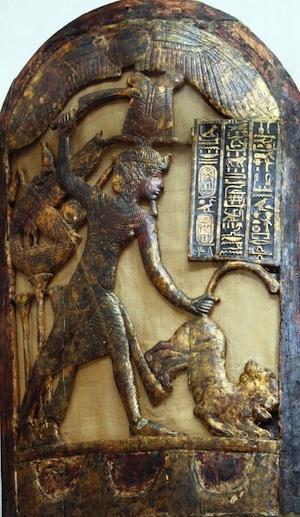

The story of Osiris (the Egyptian god of death, resurrection and fertility) determined the ritual for preparing the dead for the next world. The gods and goddesses played a vital role in Egyptian life. Wrapping could take at least two weeks to complete and take up to 300 metres of cloth. Finally, the body was wrapped with bandages. The body was anointed with unguents before being treated with molten resin. The body cavities were then packed with a combination of resin-soaked linen, bags of spices or sawdust. To completely dehydrate the body took 40 days. The body was packed in natron and fragrant resins. These organs were treated and dehydrated with natron (a natural mixture of carbonate, bicarbonate, chloride and sulphate of sodium) before being dried, anointed and immersed in molten resin. The internal organs (excluding the heart) were removed, then the brain through the nose, then the abdominal organs through a cavity cut into the left side of the abdomen. The method used in the New Kingdom period was carried out by priests and took 70 days to complete. The New Kingdom period (1567-1085 BCE) saw the practice at its most prominent. The process of treating the body (which led to mummification) was established in the Early Dynastic period (5100 - 4686 years ago) and remained the preferred method into Roman times (2030 1400 years ago). To make the transition into the next life these elements had to be reunited in the body, so the body needed to be preserved. Vessels such as these were often placed in the grave with the deceased, along with other everyday items or items signifying wealth and prestige.Īncient Egyptians believed in three essential human elements, the ka (the 'double' of the person), the ba (the soul) and the akh (the spirit). The ceramics are characteristically black in colour, which is the result of the technique of firing used in their manufacture. The Chimor kingdom extended from the river valleys of northern Peru to the central coast, and the ceramics occur across this large area. Grave GoodsĬhimu culture ceramics were made during the Late Intermediate Period (1000-1476) where the practice of wrapping the deceased within a mummy bundle before burial was common. The mummified bodies of sovereigns were cared for by attendants and were exhibited during religious and state ceremonies.

The mummies were often buried with every day items such as ceramics, clothing and other tools and utensils.ĭuring the Incan Empire (1476-1534) the Spanish recorded detailed accounts of the mummified bodies of Incan sovereigns being paraded through the streets. This practice continued through the Late Intermediate period (1000-1476), with both fabric and rope bindings used for these bundles. False heads and human hair wigs were often attached to the bundles. The positioning of the body and the fabric bindings served to draw out the decomposing fluids of the body and, with the dry conditions, resulted in the mummification of the body. The body was placed on a basket or gourd and then wrapped with fabric. In the Middle Horizon period (1400 to 1000 years ago) the dead were wrapped in a seated, upright position (with the knees at the face) within mummy bundles. Deliberate mummification was practised by some cultures but many were preserved by assisting the body to mummify using the natural conditions. Many different cultures lived in the Andean region and the treatment of the dead varied considerably. Most of the mummies found to date are naturally mummified but this region is also home to the oldest deliberately preserved mummies in the world - the Chinchorro mummies of northern Chile which date back about 7000 years ago. However, the origins of mummification are unclear. The earliest evidence for mummification in the central Andean region of South America (parts of present-day Peru, Bolivia, Chile and Ecuador) dates back 9000 years.


 0 kommentar(er)
0 kommentar(er)
